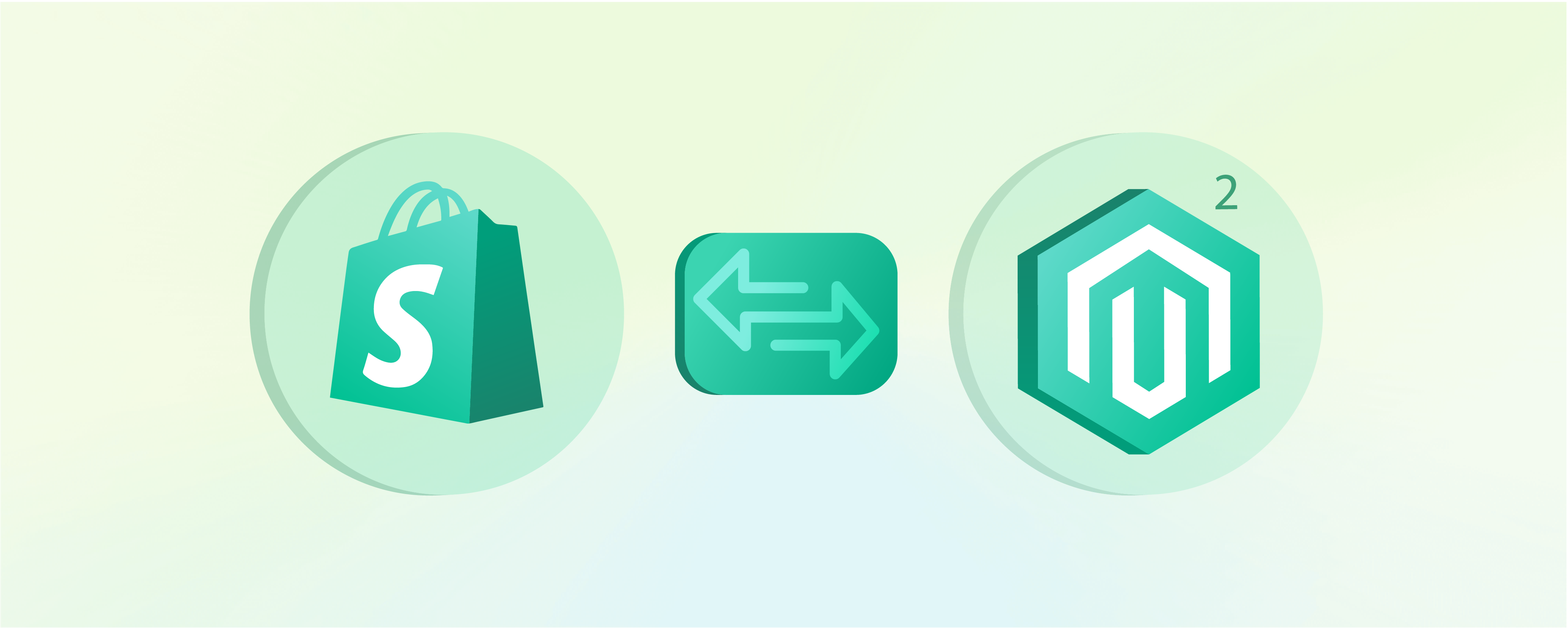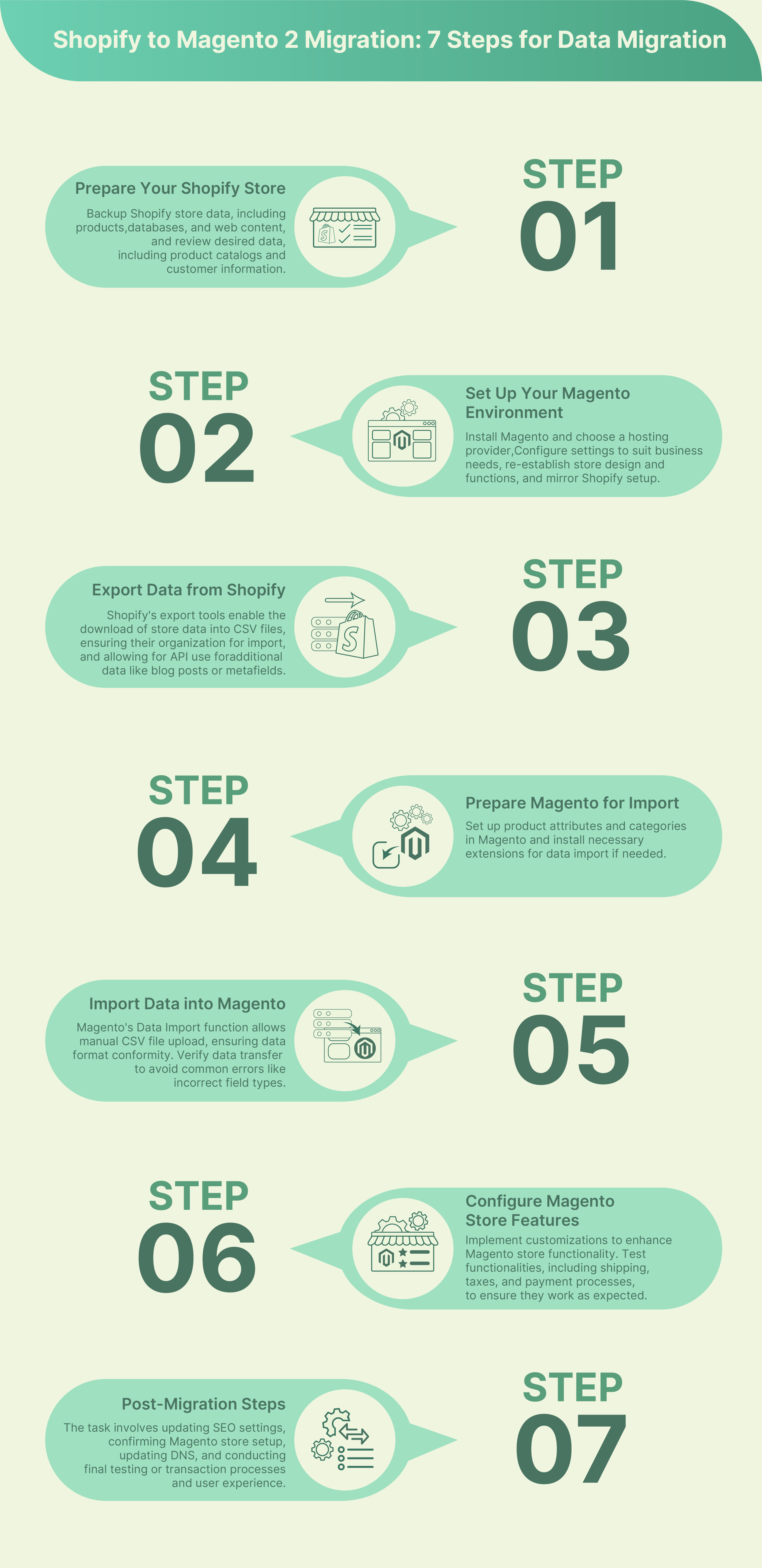
Shopify To Magento 2 Migration: 7-Step Checklist
Are you thinking about expanding your Shopify store's potential? Shopify to Magento migration is the strategic move you need. It involves transferring essential data from your Shopify store to a new or existing Magento store.
This article is your comprehensive guide to migrating from Shopify to Magento 2. It covers the reasons, methods, and a detailed guide to the migration process.
Key Takeaways
-
Discover the benefits of migrating from Shopify to Magento.
-
Explore three efficient ways to migrate from Shopify to Magento 2.
-
Learn how to perform a seamless Shopify to Magento 2 migration in seven simple steps.
-
Find out the advantages of Magento hosting for Shopify to Magento migration.
Why Migrate from Shopify to Magento?
| Feature | Shopify | Magento 2 |
|---|---|---|
| Custom Design | Limited customization options for templates and themes. | Highly customizable designs. Page Builder offers unique, brand-centric websites. |
| Omnichannel | Integrates with several channels but can be restrictive. | Superior omnichannel capabilities for a seamless customer experience. |
| Third-Party Integration | Limited support for integrations. | Extensive API support for third-party services. E.g., ERP, CRM, etc. |
| Flexibility | Basic flexibility suited for smaller retailers. | The open-source platform offers extensive flexibility. Model-view-controller makes it highly customizable. |
| Control Functionality | User-friendly but limited control over the backend. | Full control over both front-end and back-end processes. |
| Price | Monthly subscription fees. It includes additional costs for many features. | More cost-effective at scale. |
| Target Audience | Ideal for small to medium-sized businesses. | Best suited for medium to large businesses that need scalability. |
3 Ways To Migrate Shopify to Magento 2
1. Automated Migration Using a Third-party Tool
- Tools Used: Utilize third-party solutions like LitExtension, Cart2Cart, and Firebear Studio.
- Data Transferred: Products, orders, and customers.
- Cost: Depends on the volume of data. Generally, design, customizations, or shipping settings are not included.
- Pros: Efficient and less prone to error.
- Cons: Does not migrate design or custom settings.
2. Manual Migration
-
Process: Export data from Shopify, typically into a
CSV file, and import it manually into Magento. - Time and Complexity: It is time-consuming and involves a steep learning curve.
- Cost: Cheapest option. You incur indirect costs from time spent and potential errors.
- Pros: Full control over the migration process.
- Cons: High potential for errors and requires in-depth technical knowledge.
3. Agency Assisted Migration
- Service: Engage a professional Magento hosting provider or migration service.
- Safety: High level of accuracy and security in data transfer.
- Cost: More expensive. It depends on store size, design, and functionality.
- Pros: Ensures comprehensive data migration. It includes design and custom features.
- Cons: Costliest option.
Shopify to Magento 2 Migration: 7 Steps for Data Migration

Step 1: Prepare Your Shopify Store
- Backup Data: Ensure you back up your Shopify store data. It includes products, databases, media folders, web content, customers, and orders.
- Review Data: Check the data you want to migrate. Include product catalogs and customer information.
Note: custom designs and tax configurations cannot be migrated. It must be set up again in Magento.
Step 2: Set Up Your Magento Environment
-
Install Magento: If not already set up, install the latest version of Magento on your server. Choose a Magento hosting provider
-
Configure Settings: Adjust the basic configurations to suit your business needs. Re-establish your store’s basic design and functions to mirror your Shopify setup.
Step 3: Export Data from Shopify
-
Use Export Tools: Utilize Shopify’s export functionality. It helps download your store data into CSV files.
-
Organize Files: Ensure your CSV files are well-organized and ready for import.
-
API Use: For additional data like blog posts or metafields, utilize Shopify’s API.
Step 4: Prepare Magento for Import
-
Create Attributes: Set up necessary product attributes and categories in Magento.
-
Install Import Extensions: Install necessary Magento extensions for data import, if needed.
Step 5: Import Data into Magento
-
Manual Import: Use Magento's Data Import function to upload your CSV files. Adapt the Shopify CSV data to fit Magento’s format requirements. Download a sample Magento CSV file from System > Data Transfer > Import. Update it with the data from Shopify’s CSV.
-
Check Data: Verify that all data has been transferred correctly. Avoid common Magento errors, such as incorrect field types.
Step 6: Configure Magento Store Features
-
Set Up Customizations: Implement any required customizations and advanced settings. It helps enhance your Magento store’s functionality.
-
Test Functionalities: Ensure all features work as expected. Perform a test order to confirm the various functionalities. It includes shipping, taxes, and payment processes.
Step 7: Post-Migration Steps
-
SEO Adjustments: Update SEO settings to maintain search engine ranking.
-
DNS Update: Confirm the successful setup of your Magento store. Next, update your DNS settings to point your domain to the new Magento server.
-
Final Testing: Conduct thorough testing of the Magento store. It includes transaction processes and Magento user experience.
Advantages of Magento Hosting for Shopify to Magento Migration
1. Performance Optimization
Magento hosting is tailored to maximize the performance of Magento stores. It includes configuring server resources like:
- Memory
- CPU, and
- Disk I/O
Full-page caching and Varnish are often employed to reduce load times. It improves the responsiveness of your Magento store.
2. Scalability
Magento hosting solutions are designed to handle increasing traffic and data loads seamlessly.
Scalable server solutions dynamically adjust to your store’s traffic and data volume. Auto-scaling ensures that your Magento store remains operational and efficient as it grows.
3. Security
Magento hosting includes specialized security measures. It includes:
- Regular security patches
- Secure data centers, and
- Specialized Magento firewalls
These features are optimized for the Magento eCommerce platform. It ensures better protection against common threats and vulnerabilities in the eCommerce landscape.
4. Technical Support
Providers of Magento hosting services typically offer expert support specifically for Magento issues. It includes:
- 24/7 monitoring
- Direct access to skilled technicians
- Proactive troubleshooting
This specialized support is invaluable during and after the migration process.
5. Compatibility
Magento hosting ensures compatibility with all Magento features and extensions. It avoids common integration issues that might occur with general web hosting services. It includes native support for Magento extensions and third-party APIs.
6. Enhanced Customization
Hosting on a platform optimized for Magento allows for greater customization capabilities. Magento's open-source nature, paired with specialized hosting, enables deep customization. It helps meet specific business needs.
7. Automated Backups
Many Magento hosting providers include automated backup services. It ensures that data is regularly saved and can be restored if needed. It is particularly important during the migration process to safeguard your data. These backups are often scheduled during low-traffic hours and can be easily restored.
FAQs
1. What is the Shopify to Magento migration process?
Shopify to Magento migration process involves transferring essential data. It is done from your existing Shopify online store to a new Magento store. It includes products, customers, and orders. It also includes other relevant information necessary for your ecommerce platform.
2. How does Litextension help in the migration service?
LitExtension is a third-party tool that facilitates automated migration from Shopify to Magento. It assists in transferring data seamlessly. It includes product categories, customer information, and orders. It minimizes manual effort and potential errors in the process.
3. What are the benefits of migrating from Shopify to Magento?
Migrating from Shopify to Magento opens up opportunities for advanced customization. It improves the scalability of your online store. Magento offers an open-source platform with extensive flexibility and superior omnichannel capabilities. It caters to medium to large businesses' needs.
4. How do I set up my new Magento store after migration?
After migrating, you need to set up your Magento store environment. It involves installing the latest version of Magento on your server. Next, configure basic settings to mirror your previous Shopify setup. Implement any necessary customizations to enhance your store's functionality.
5. Can I test the migration process before fully migrating to Magento?
Yes, you can conduct a demo migration to test the migration process from Shopify to Magento. It allows you to verify the accuracy of data transfer. You can ensure that all features and functionalities work as expected. It helps decide before fully committing to the migration.
Summary
Shopify To Magento Migration ensures a seamless transition of essential data. Magento transfer helps businesses provide a superior customer experience. Here are the steps to migrate:
- Prepare your Shopify store by backing up and reviewing data.
- Set up your Magento environment with the latest version and configure settings.
- Export data from Shopify using export tools, organizing files, and utilizing APIs.
- Prepare Magento for import by creating attributes and installing extensions.
- Import data into Magento through manual import and verify data accuracy.
- Configure Magento store features, including customizations and testing functionalities.
- Perform post-migration steps such as SEO adjustments, DNS updates, and final testing.
Don't let the migration process intimidate you – Explore Magento server hosting options to ensure a smooth migration process and optimize your new Magento store.


